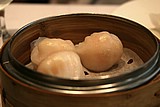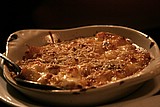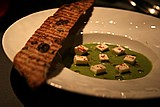Home |
Restaurants by City
|
Food Photography |
Archive | Philosophy |
![]()
Right now we are eating in Seattle, Washington.
|
Saturday
2005
Permalink
|
Food News, May 28, 2005 Mark Bittman, New York Times food writer and author of How to Make Everything, a super useful and popular cookbook has a new TV series and book. In the series Bittman challenges top/famous chefs across the country where they both cook the same basic dish in two different styles. The chef does their restaurant version while Bittman does a homemade version. True to his "minimalist" identity his dishes tend to simplify and reduce. And while not identical to their counterparts, they appear to have an elegance about them due to their simple focus and execution. In town promoting the show, Bittman stopped by Lampreia to do one of these demonstrations (though not for the show) with Scott Carsberg, the chef at Lampreia. Hsiao-Ching Chou of the Seattle PI does a great job describing the back and forth between the two as well as delivering the recipes for the two dishes that resulted. ∞ I love the Onion. I'm not sure if this is strictly on topic, but it's pretty good nonetheless. Have you been to the new "Not Quite Perfect McDonalds"? ∞ It's funny (dumb funny not ha-ha funny) how different foods get so trendy. I have always loved a good cupcake. Not the supermarket frozen-in-time cupcakes in their see-through cages by the baked goods, but a fresh cupcake with creamy frosting and moist cake from a bakery. I don't love them any more then I ever have (which was already quite a bit). But given how suddenly so many "boutique" cupcake bakeries have sprouted up you'd think they were a new invention. I suppose it doesn't matter why people are suddenly trying to elevate the cupcake as long as they do. The LA times (free registration required) has the rundown of the best cupcakeries in Los Angeles. The one near my house is called Cupcake Royale in the Verite coffeehouse. The one cupcake I've eaten there was certainly serviceable. Not terrible, but not spectacular. I should reserve judgment until I've eaten a few more. That cupcake did however produce one of my favorite moments ever. |
|
Our Sponsors
Free Car Listings Hot Tubs Stools Saunas Bar Stools - Calendar and Event Schedules - Food Events and Calendars - Wine Events and Calendars - Digital Photography Resources - Software for Advertisers - Jewish Gifts and Judaica - Howard Stern Podcast - ponytailed blogger Jonathan Schwartz

Browse tastingmenu
Home |
Restaurants by City X |
Food Photography |
Archive | Philosophy |
![]()
Free eBooks: All About Apples
| Autumn Omakase
More:
Discussion |
Cool Food T-Shirts |
Ingredients
| Markets |
Recipes
Search |
Blog FAQ |
Other
Blogs
Best of tastingmenu
|
City View
Entry: July 6, 2006 |
Blue Plate
Entry: June 19, 2006 |
L'Atelier de Joël Robuchon
Entry: July 18, 2006 |
Browse by City
Boston | Chicago | Houston | Las Vegas | Los Angeles | Maui | New York | Philadelphia | Portland | San Francisco | Seattle | Toronto | Utah | Vancouver | Washington D.C.
Bangkok | Beijing | Hong Kong | Seoul | Tokyo
Amsterdam | Berlin | Italy | London | Madrid | Paris | Vienna
Browse by Month
2006
2005
2004
2003
2002
2001
Comments, questions, or feedback:
info / at / tastingmenu / dot / com
All pages Copyright (c) 2001-2006 tastingmenu.com
Last modified 01/30/07.



